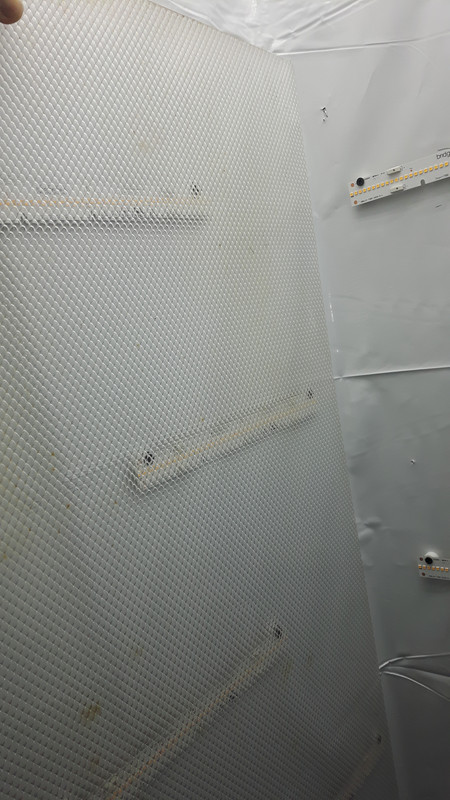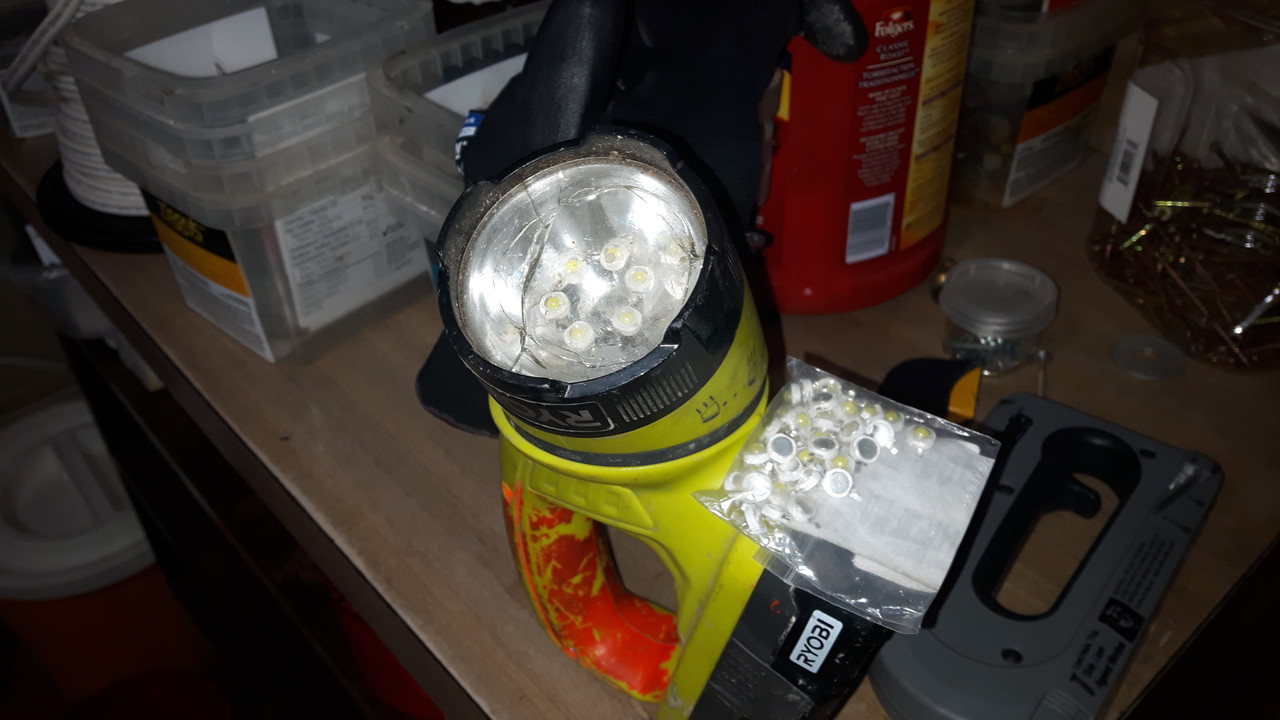-
ICMag with help from Landrace Warden and The Vault is running a NEW contest in November! You can check it here. Prizes are seeds & forum premium access. Come join in!
You are using an out of date browser. It may not display this or other websites correctly.
You should upgrade or use an alternative browser.
You should upgrade or use an alternative browser.
Diary PCBuds mini-grow
- Thread starter PCBuds
- Start date
PCBuds
Well-known member
I got the 4 ceiling strips wired up and operating.
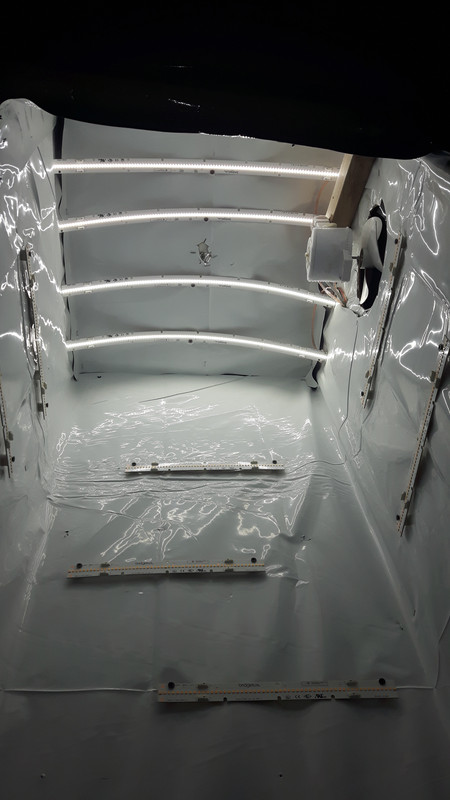
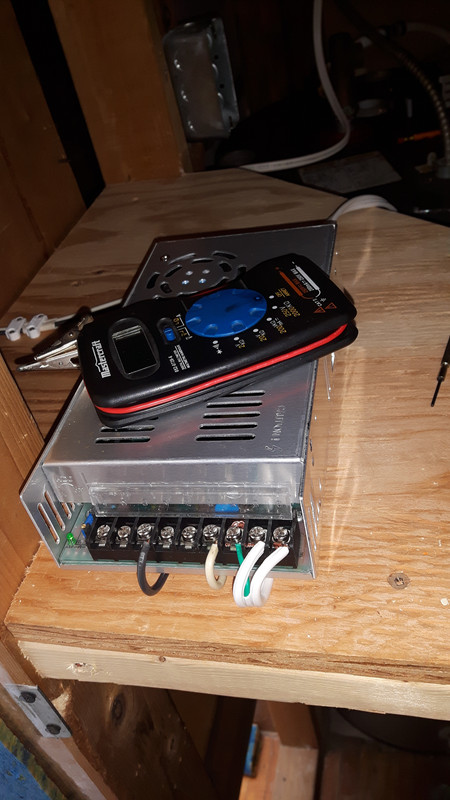
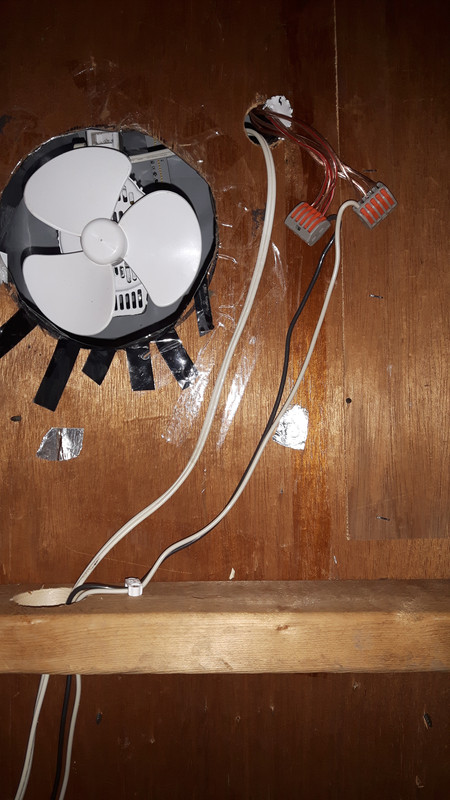
I've still got wire up the timer and contactor but I'm going to leave the lights on and keep an eye on the voltage.
Apparently, the driver needs a burn-in period for everything to stabilize.
I'll keep touching the strips to see how warm they get.
They're running right around 19.6 V now.



I've still got wire up the timer and contactor but I'm going to leave the lights on and keep an eye on the voltage.
Apparently, the driver needs a burn-in period for everything to stabilize.
I'll keep touching the strips to see how warm they get.
They're running right around 19.6 V now.
PCBuds
Well-known member
I just did some measuring and calculations and it's not looking too bad.
My 4 two-foot strips are running at ~19.5 V and drawing 3.5 A total, so 68.25 Watts.
My LED driver is drawing 90.5 Watts from the wall outlet.
So 68.25 ÷ 90.5 is ~75% efficient.
Not too bad.
With the lights disconnected and the driver still on, it draws 5 Watts with the little built-in fan running.
The rated test current is 700 mA with a max of 1,400 mA for each strip.
I'm running them at 3500 mA for all 4, so 875 mA each.
I just went and touched the backside of the strips and they're getting a bit hot, not as hot as some of my SILs got but I'm gonna turn them down to the test current.
So 700 mA X 4 is 2,800 mA or 2.8 Amps total.
My 4 two-foot strips are running at ~19.5 V and drawing 3.5 A total, so 68.25 Watts.
My LED driver is drawing 90.5 Watts from the wall outlet.
So 68.25 ÷ 90.5 is ~75% efficient.
Not too bad.
With the lights disconnected and the driver still on, it draws 5 Watts with the little built-in fan running.
The rated test current is 700 mA with a max of 1,400 mA for each strip.
I'm running them at 3500 mA for all 4, so 875 mA each.
I just went and touched the backside of the strips and they're getting a bit hot, not as hot as some of my SILs got but I'm gonna turn them down to the test current.
So 700 mA X 4 is 2,800 mA or 2.8 Amps total.
PCBuds
Well-known member
I'm intending to run the 4 two footers on the ceiling with one driver then all the 24 one footers on the walls off of the other driver.
So the second driver will have 3 times as many total LEDs to power.
That way I can keep the ceiling and its cool white LEDs at the max output (based on finger temperature) and adjust the warm white walls up and down separately.
The driver for the ceiling is hard to adjust and you need a tiny screwdriver to do it.
The driver for the walls has a handy dial for adjustment and a digital voltage readout built-in so it's much easier to adjust and I figure it will be the walls that I'm adjusting the most.
I just turned down the driver for my ceiling and the voltage went from ~19.5V to 19.32 V but the current went from 3,500 mA to 2,800 mA. So it's tough to judge the power by the voltage.
However, I'm going to be judging everything by temperature so I only need to do a few measurements with my ammeter, which is easy to screw up.
I touched the probes right across the voltage and popped a fuse in my meter... Oops. Lol
So the second driver will have 3 times as many total LEDs to power.
That way I can keep the ceiling and its cool white LEDs at the max output (based on finger temperature) and adjust the warm white walls up and down separately.
The driver for the ceiling is hard to adjust and you need a tiny screwdriver to do it.
The driver for the walls has a handy dial for adjustment and a digital voltage readout built-in so it's much easier to adjust and I figure it will be the walls that I'm adjusting the most.
I just turned down the driver for my ceiling and the voltage went from ~19.5V to 19.32 V but the current went from 3,500 mA to 2,800 mA. So it's tough to judge the power by the voltage.
However, I'm going to be judging everything by temperature so I only need to do a few measurements with my ammeter, which is easy to screw up.
I touched the probes right across the voltage and popped a fuse in my meter... Oops. Lol
PCBuds
Well-known member
I just went and touched the backside of my strips again, and the temperature has gone way down. It's warm, but not hot.
I remember my electronics teacher way back in 1980 saying that "If it's too hot to touch, then it's too hot".
That still makes a lot of sense... and it's a lot easier than measurements and calculations and math...
Just stick your finger in it. Lol ��
I remember my electronics teacher way back in 1980 saying that "If it's too hot to touch, then it's too hot".
That still makes a lot of sense... and it's a lot easier than measurements and calculations and math...
Just stick your finger in it. Lol ��
PCBuds
Well-known member
Both my LED drivers are rated 500 Watt output.
All my one-foot strips should draw about 3 times the power of my ceiling strips, ... so about 270 Watts.
That's just over half it's rated output, and that should be what it draws from the wall, not it's output so I'm thinking everything should be fine.
I could run all my strips off of one driver but I've got two so I thought I'd use them... That way, if one craps out I can switch all lights to the good driver.
Maybe I'll buy another one. It's fun to buy stuff, and I'm still spending less than buying weed. Lol
All my one-foot strips should draw about 3 times the power of my ceiling strips, ... so about 270 Watts.
That's just over half it's rated output, and that should be what it draws from the wall, not it's output so I'm thinking everything should be fine.
I could run all my strips off of one driver but I've got two so I thought I'd use them... That way, if one craps out I can switch all lights to the good driver.
Maybe I'll buy another one. It's fun to buy stuff, and I'm still spending less than buying weed. Lol
PCBuds
Well-known member
I remember SuperBadGrower posted this and it makes sense to me.
"The benefits of light diffusion in greenhouses is subject of academic study. It could be true that less, but more diffuse light causes equal photosynthesis compared to more intense less diffuse light. Personally I have seen the benefits of diffuse light going from HID (not diffuse) to COB (semi diffuse), to strips (very diffuse)."
So with that in mind, I think I'm going to have my ceiling lights on full blast as soon as I plant the germinated seed into the cooler.
Then, once it spouts two sets of leaves, turn on the side lighting and turn it up to max over the course of a few days.
The ceiling lights are 56" from the soil but they're reasonably bright and I have the Panda Film all around my closet which is ~90% reflective.
It would be nice to just "set it and forget it" and let the plant grow into its environment.
I believe the plant won't get too tall because it will have all the light it needs and won't have to waste its resources stretching to get light.
"The benefits of light diffusion in greenhouses is subject of academic study. It could be true that less, but more diffuse light causes equal photosynthesis compared to more intense less diffuse light. Personally I have seen the benefits of diffuse light going from HID (not diffuse) to COB (semi diffuse), to strips (very diffuse)."
So with that in mind, I think I'm going to have my ceiling lights on full blast as soon as I plant the germinated seed into the cooler.
Then, once it spouts two sets of leaves, turn on the side lighting and turn it up to max over the course of a few days.
The ceiling lights are 56" from the soil but they're reasonably bright and I have the Panda Film all around my closet which is ~90% reflective.
It would be nice to just "set it and forget it" and let the plant grow into its environment.
I believe the plant won't get too tall because it will have all the light it needs and won't have to waste its resources stretching to get light.
PCBuds
Well-known member
I just took some more accurate measurements at the test current.
The driver was drawing 64.5 Watts from the wall.
The driver was putting out 2.796 Amps at 19.35 Volts.
2.796 X 19.35 = 54.102 Watts.
54.102 ÷ 64.5 = 83.88% efficiency of my driver.
So that's looking pretty good!!
My biggest concern is my driver crapping out on me but I think I should be fine.
I'm not going to switch it on and off with the timer, I'm going to switch the output on and off.
When I plugged the driver into the Wattmeter, I could hear the plug sparking.
It's got a huge surge current and it's when something is first plugged in that it tends to fail.
PS... Thanks, f-e for filling me in on this contactor.
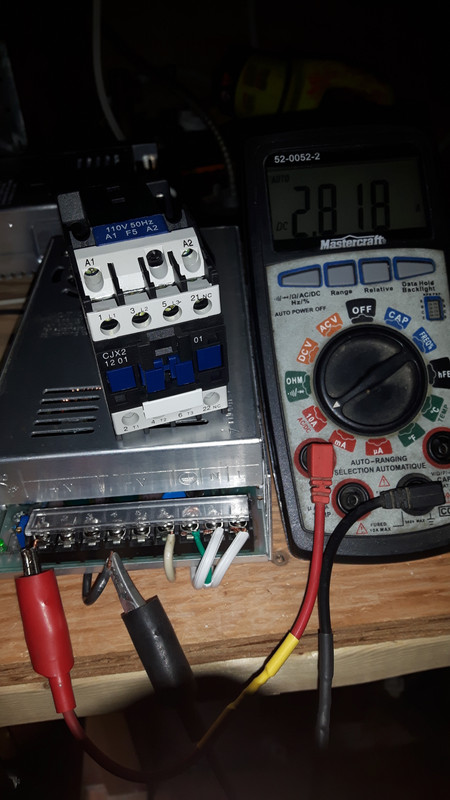
I never heard of such a thing until you told me about it.
It kicks Ass!!!
I can switch my whole house on and off with it!!! Lol
The driver was drawing 64.5 Watts from the wall.
The driver was putting out 2.796 Amps at 19.35 Volts.
2.796 X 19.35 = 54.102 Watts.
54.102 ÷ 64.5 = 83.88% efficiency of my driver.
So that's looking pretty good!!
My biggest concern is my driver crapping out on me but I think I should be fine.
I'm not going to switch it on and off with the timer, I'm going to switch the output on and off.
When I plugged the driver into the Wattmeter, I could hear the plug sparking.
It's got a huge surge current and it's when something is first plugged in that it tends to fail.
PS... Thanks, f-e for filling me in on this contactor.

I never heard of such a thing until you told me about it.
It kicks Ass!!!
I can switch my whole house on and off with it!!! Lol
PCBuds
Well-known member
I've always heard you don't want to hot swap the DC side of the driver...
Huh, ??
I don't know know what that means??
I think you mean switching the output on and off??
Why not??
PCBuds
Well-known member
Not sure why, it was something Growmau5 said on one of his ChilLED Logic videos.
Perhaps shutting the output on and off sends a surge back into the driver???
I remember my friends' dad owned a roller skating rink in 1981.
They kept blowing up their amps for their sound system.
$700 each time... each amp.
An electrician checked them out and said "keep them on and just turn them down"
They didn't blow up any more amps after they did that...
If it were an LED driver, disconnecting the load would be seen as a drop in current. The driver would use as much voltage as required to reach the current it's meant to produce, so with no load connected, the driver would reach full voltage and sit there. I have some Osram drivers for a 36V led, that will ramp up to around 50v open circuit. That is quite a lot to then reconnect. I looked at a Meanwell yesterday, destined for 30v use, it would use to up 32v and had an over voltage protection set 33-37 volts.
You seem to have a PSU not an LED driver. It just cares about maintaining the output voltage. You could stick it on your lights. Then in your coffee. Then in your ear. Then back on the lights again. It's not an issue.
I don't actually see a need to switch the DC not AC, but don't add a capacitor as the PSU output needs to stabilise within a short timescale or the PSU may not start. I have had such issue's with 12v pumps. Leading to me making a tiny delay line in the wire from the psu to the pump.

Whichever side you switch, the contactor will be needed. Standard wall wort timers will just weld. One suited to a 600 should work though.
Ultimately, switching the DC means your wiring is all safe to touch and there will be no starting issues. Well.. most of the wiring. You still need 110 to energise that coil.
You seem to have a PSU not an LED driver. It just cares about maintaining the output voltage. You could stick it on your lights. Then in your coffee. Then in your ear. Then back on the lights again. It's not an issue.
I don't actually see a need to switch the DC not AC, but don't add a capacitor as the PSU output needs to stabilise within a short timescale or the PSU may not start. I have had such issue's with 12v pumps. Leading to me making a tiny delay line in the wire from the psu to the pump.
Whichever side you switch, the contactor will be needed. Standard wall wort timers will just weld. One suited to a 600 should work though.
Ultimately, switching the DC means your wiring is all safe to touch and there will be no starting issues. Well.. most of the wiring. You still need 110 to energise that coil.
https://www.ebay.com/itm/XL4016-DC-...524162&hash=item4adf741a49:g:DCoAAOSwsvpbNIHE
That will take 40v at the input, and let you set the output as high as 35v. While the current can also be set, which it limits by rapidly switching. It actually lists LED driving as a use.
You could use a $2 power meter permanently
https://www.ebay.com/itm/DC-100V-10...noa=1&pg=2047675&_trksid=p2047675.c100623.m-1
But while they measure above 30v, they can't use over 30v internally, so you need something like this, but a 110v version
https://www.ebay.com/itm/LED-driver...76:m:mFPeOTg38k4IHJVu9Fajz8Q&var=631881772376
That would be a nice $7 spend
That will take 40v at the input, and let you set the output as high as 35v. While the current can also be set, which it limits by rapidly switching. It actually lists LED driving as a use.
You could use a $2 power meter permanently
https://www.ebay.com/itm/DC-100V-10...noa=1&pg=2047675&_trksid=p2047675.c100623.m-1
But while they measure above 30v, they can't use over 30v internally, so you need something like this, but a 110v version
https://www.ebay.com/itm/LED-driver...76:m:mFPeOTg38k4IHJVu9Fajz8Q&var=631881772376
That would be a nice $7 spend
PCBuds
Well-known member
You seem to have a PSU not an LED driver. It just cares about maintaining the output voltage. You could stick it on your lights. Then in your coffee. Then in your ear. Then back on the lights again. It's not an issue.
Yes, it is a 24 Volt power supply that I am using as an LED driver.
There was a warning that came with it saying that it doesn't limit the current.
I don't actually see a need to switch the DC not AC, ....
Whichever side you switch, the contactor will be needed. Standard wall wort timers will just weld. One suited to a 600 should work though.
Ultimately, switching the DC means your wiring is all safe to touch and there will be no starting issues. Well.. most of the wiring. You still need 110 to energise that coil.
I want to leave the PSUs on all the time in the hope that it will help them last longer. I'm thinking they will warm up and stabilize.
In the reviews for the unit on Amazon, a few people said that they worked for a month and then failed.
I intend to have my timer operating the contactor and have the contactor switching the 19.5 V output of the PSUs on and off.
So if there is no issue with switching the PSUs output, then that's the way I want to do it.
They only draw 5 Watts of power when they are on and the output disconnected.
PCBuds
Well-known member
https://www.ebay.com/itm/XL4016-DC-...524162&hash=item4adf741a49:g:DCoAAOSwsvpbNIHE
That will take 40v at the input, and let you set the output as high as 35v. While the current can also be set, which it limits by rapidly switching. It actually lists LED driving as a use.
You could use a $2 power meter permanently
https://www.ebay.com/itm/DC-100V-10...noa=1&pg=2047675&_trksid=p2047675.c100623.m-1
But while they measure above 30v, they can't use over 30v internally, so you need something like this, but a 110v version
https://www.ebay.com/itm/LED-driver...76:m:mFPeOTg38k4IHJVu9Fajz8Q&var=631881772376
That would be a nice $7 spend
I was actually just looking at this yesterday...
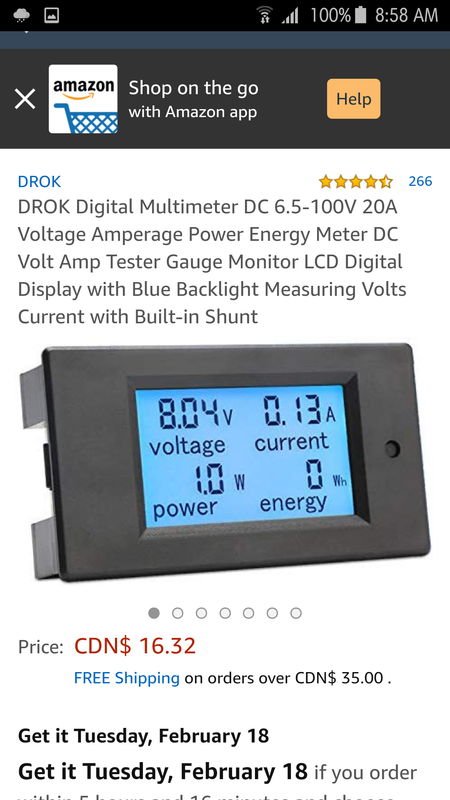
I don't think I really need it though...
I just wanted to measure the current to have an idea of what it was at.
Perhaps in the summer, when the whole closet is warmer and it's filled up with a finishing plant, I'll measure it again.
I'm just going to keep touching the strips and adjust the power based on their temperature.
I'll have them as bright as possible before they get too hot.

